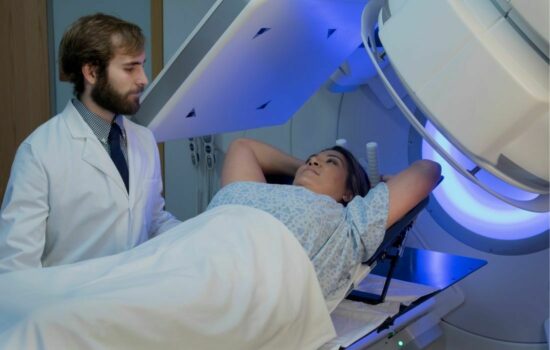May 12, 2022
What You Should Know About Radiation Therapy for Breast Cancer Treatment

Radiation therapy is a treatment that can be used for many different types of cancer to target cancer cells and minimize tumor growth. Radiation therapy works by using high-energy beams or particles to damage the DNA of cancer cells, which prevents them from dividing, and results in the death of the cell.
Radiation therapy is often used for breast cancer patients to make sure any remaining cancer cells are killed after surgery or if cancer has spread to other areas of the body. Read on to learn more about the types of radiation therapy, when radiation therapy is used to treat breast cancer, what to expect at a radiation oncology appointment, and the side effects of radiation therapy.
Types of Radiation Therapy for Breast Cancer
There are two primary types of radiation therapy for breast cancer treatment: external beam and internal radiation. External beam radiation is targeted on the skin outside of the body, whereas internal radiation focuses on treatment within the body.
External Beam Radiation Therapy for Breast Cancer Patients
External beam radiation therapy uses high-energy rays onto the tumor or cancerous location. Technology and software are used to determine the exact area of the body where the cancerous cells are located in order to avoid treating healthy cells with radiation. The patient lies down on a table with the linear accelerator used to deliver radiation therapy. Each time, the machine is pointed to the same location on the body, with each session lasting only 15-30 minutes. Typically the process of external beam radiation therapy is completed over several weeks.
A newer approach to external beam radiation therapy is hypofractionated radiation therapy. Your radiation oncologist may be able to deliver the same amount of radiation treatments over a shorter time frame, such as 4-5 weeks rather than 6-8 weeks. This is done by using a higher dose in each session. This is often an option for breast cancer patients.
Internal Radiation Therapy Use in Breast Cancer
The main type of internal radiation therapy used to treat breast cancer is called High-Dose Rate (HDR) brachytherapy. HDR brachytherapy can be used for some patients with early-stage breast cancer. After a lumpectomy, a procedure is performed to place an applicator into the breast. This applicator contains a few tubes that hold the radioactive seeds. Over the course of a few days, the seeds will be placed in the applicator to kill any remaining cancer cells left inside the breast. Once treatment is done, the applicator is removed. HDR brachytherapy is a much shorter process than external beam radiation therapy for breast cancer but is not available to every patient based on the size, stage, and type of breast cancer.
When is Radiation Therapy Used For Breast Cancer?
Radiation therapy may be recommended as a treatment option following a lumpectomy (breast surgery to remove the tumor) or to treat more advanced stages of cancer. It may also be suggested to use other treatments, such as chemotherapy combined with radiation therapy. This is called neoadjuvant therapy and is largely dependent on each patient’s individualized treatment plan.
Radiation Therapy Before Breast Cancer Surgery
Neoadjuvant therapy is when radiation therapy treatments are done before breast surgery to reduce the size of the tumor before removal. This can minimize cancer cells from potentially spreading during surgery, reduce the amount of tissue removed, and aid with swelling.
Radiation Therapy After Lumpectomy
A lumpectomy is a breast-conserving surgery that only removes the cancer and surrounding tissue to keep as much of the breast as possible. Patients often receive external beam radiation therapy or HDR brachytherapy following their surgery to ensure that any potential cancer cells are gone. This makes the cancer less likely to return, although it’s not a guarantee.
Radiation Therapy After Mastectomy
A mastectomy is a surgery to remove the entire breast. Rarely is radiation therapy required for these patients. However, your oncologist might recommend it if there are enough risk factors for the cancer returning in the future, such as the number of affected lymph nodes, your BRCA gene status, and the size and location of the cancer.

Radiation Therapy for Metastatic Breast Cancer
Metastatic breast cancer refers to cancer that has spread to various parts of the body. If the cancer spreads to other areas of the body, it’s still treated as breast cancer. Radiation therapy can be used to reduce the size of the tumors in the breast as well as outside of the breast.
What to Expect at a Radiation Oncology Appointment
During your first appointment with the radiation oncologist, several images will be taken to create a treatment plan. These images, usually from a CT scan, make it possible to deliver the radiation precisely where the cancer is located. You may go through a simulation where your body is lined up with low-level lasers to be sure your position is precise. The radiation therapists place you on the linear accelerator to determine your position for each treatment session. You most likely won’t receive treatment during this first appointment.
Your treatment schedule will also be determined so that your radiation therapy sessions take place approximately 5 days a week over several weeks. During each visit, you’ll be evaluated for any side effects. Be sure to talk to the team if you are feeling anything unusual.
Watch the video below to learn more about what to expect during radiation therapy treatment at the Cancer Care Centers of Brevard.
What Are the Side-Effects of Radiation Therapy and How Can They be Managed?
Although radiation therapy treatments are typically painless, you may experience side effects. This will vary depending on the type of radiation therapy treatment received. Discuss the possible side effects with your doctor so that you are prepared.
Some short-term side effects of radiation therapy may include:
Swelling in the breast
Fatigue
Discomfort in the target area, this can feel like a sunburn
Changes in the sensitivity of your skin
Fluid collection in the breast
Long-term side effects of radiation therapy can include:
Heart or lung problems
Damage to fatty tissues in the breasts
A spider vein appearance (telangiectasias)
Make sure to keep your radiation oncologist informed if you experience any of these side effects. You can tell the radiation therapist, too, and they can help you or talk with the doctor about possible side-effect management options.
Radiation Therapy for Breast Cancer Treatment in Brevard County
The breast cancer specialists at Cancer Care Centers of Brevard are focused on helping patients work through their breast cancer journey. Each treatment plan is made with the patient collaboratively. To receive a personalized breast cancer treatment plan or a second opinion, request an appointment at one of our locations in Brevard County, including Palm Bay, Melbourne, and Merritt Island, FL.
Read our frequently asked questions and answers about radiation therapy treatments to learn more if you have additional questions. Our cancer specialists are knowledgeable, compassionate, and educated on the latest breast cancer treatments.
Categories: Breast Cancer, Cancer Treatments